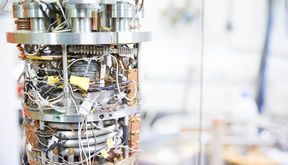Low temperature physics in a comment series published in the Nature Physics journal

The article "Physics at its coolest" by Juha Tuoriniemi, Senior Researcher at the Low Temperature Laboratory, was published as part of the new Measure for Measure column series in the Nature Physics journal at the beginning of this year.
This column series range from thermodynamics to the reform of the SI system and from low temperature physics to plasma physics.
In his article on low temperature physics, Tuoriniemi records the development of research as well as contemplates why researchers are interested in ever colder temperatures. Important discoveries in low temperature physics have been quantum matter, superfluidity and superconductivity, which only occur at very low temperatures.
‘Atoms behave in a very different way at very low temperatures and the order in the system increases, reducing the thermal noise that disturbs measurements. This phenomenon enables very precise measurements’, says Juha Tuoriniemi.
Liquefying helium was an important turning point at the beginning of the 20th century. At the time, the rules of quantum mechanics were not understood, yet, but the previously unknown principles have gradually been uncovered. It took almost forty years before the quantum properties of helium were thoroughly understood, and it became possible to exploit this in cooling techniques when two types of helium, 3He and 4He, are mixed using a suitable ratio.
Atomic quantum gases, forming so-called quantum condensates, represent a new kind of order very close to absolute zero, and are one significant area of study. When quantum gases are controlled with external magnetic fields using laser cooling, extremely low temperatures can be reached. The absolute zero is at –273.15 degrees Celcius, which is exactly 0 degrees Kelvin but, as we know, it is impossible to reach that both in theory and in practise.
Researchers at Aalto University continue to perform basic research in low temperature physics. Many universities have given it up because it is now possible to buy cryostats, i.e. coolers. For example, the Finnish company BlueFors Cryogenics Ltd, which was established in 2007 on the basis of research conducted in the Low Temperature Laboratory, offers cryostats. It has gained a significant market share in cryostats across the world.
The Low Temperature Laboratory still holds the 1999 record for the coldest solid materials, which is 100 picokelvins, i.e. 0.000 000 000 1 K. The cryostat built by the researchers, used when making the record, is still in use and serves the study of quantum matter at the moment. MIT holds the record for the lowest quantum gas temperature, 50 picokelvins, reached in 2010.
Juha Tuoriniemi
juha.tuoriniemi@aalto.fi
tel:+358503442846
Aalto University Department of Applied Physics
Low Temperature Laboratory
Read more news

Entrepreneurship offers women empowerment in late-stage careers
Launching their own venture offers older women a chance to turn their age into a competitive advantage, reveals new research.
Topics raised in the 2025 Learning Centre customer survey
Thank you to everyone who participated in the survey!
Elites wield huge influence over deepening polarisation –– now we can tell exactly how much
Researchers used network theory to develop a method for measuring the impact of individuals on societal division.






